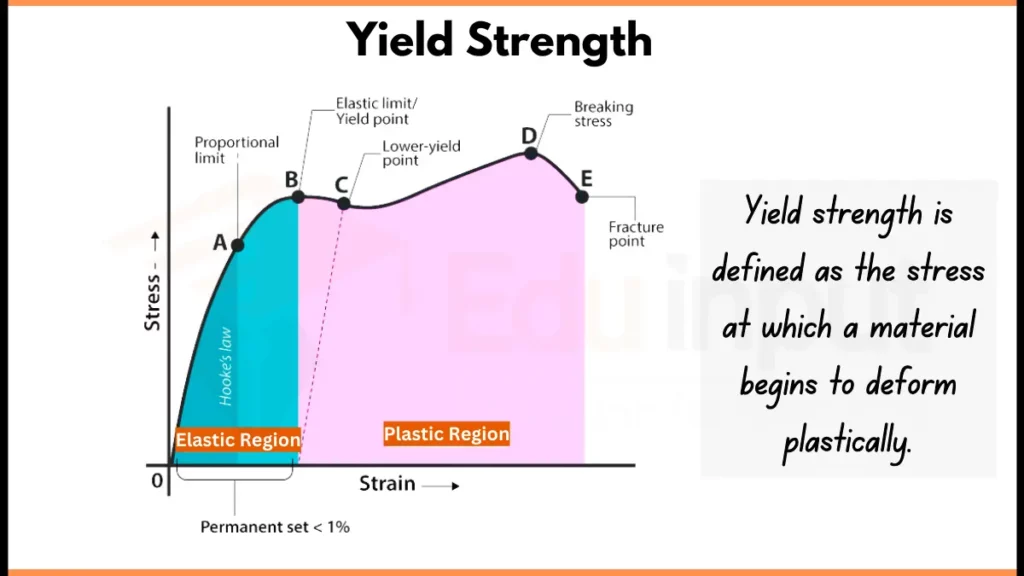Yield Strength-Definition, Measurement, Examples, and Applications
Yield strength is a key concept in materials science. It tells us when a material will start to change shape permanently. Think of a rubber band. You can stretch it, and it snaps back. But stretch it too far, and it stays stretched.
Yield strength is the point just before this happens. It’s important for engineers. They use it to design safe buildings, bridges, and machines.
To understand yield strength, we need to know about stress and strain. Stress is the force applied to an object, spread over its surface. Strain is how much the object changes shape due to this force. Most materials can handle some stress without permanent change. This is called elastic behavior.
But at a certain point, they start to deform permanently. This point is the yield strength. It’s where elastic behavior ends and plastic deformation begins.
Definition of Yield Strength
Yield strength is defined as the stress at which a material begins to deform plastically. In other words, it’s the point at which the material will no longer return to its original shape when the applied stress is removed.

This transition from elastic to plastic behavior is crucial in engineering design, as it determines the maximum stress a material can withstand without permanent deformation.
How is Yield Strength Measured?
Yield strength is typically measured through a tensile test. In this test, a sample of the material is gradually stretched while the applied force and the sample’s elongation are measured. The results are plotted on a stress-strain curve.
The yield strength is often defined as the stress that produces a small, specified amount of permanent deformation, typically 0.2% of the original length. This is known as the 0.2% offset yield strength and is determined by drawing a line parallel to the initial linear portion of the stress-strain curve, starting from 0.2% strain on the x-axis. The point where this line intersects the stress-strain curve is considered the yield strength.
Factors Affecting Yield Strength
Several factors can influence a material’s yield strength:
- Material Composition – The chemical makeup of a material significantly affects its yield strength. For example, adding small amounts of carbon to iron greatly increases the yield strength of steel.
- Heat Treatment: Processes like annealing, quenching, and tempering can alter a material’s microstructure, thereby changing its yield strength.
- Cold Working – Deforming a material at temperatures below its recrystallization temperature can increase its yield strength by increasing the number of dislocations in its crystal structure.
- Grain Size – Materials with smaller grain sizes generally have higher yield strengths due to the increased number of grain boundaries that impede dislocation movement.
Importance of Yield Strength in Engineering Applications
Yield strength is important in engineering design for several reasons:
- It helps engineers determine the maximum stress a component can withstand without permanent deformation.
- It’s used to calculate safety factors in structural designs.
- It guides material selection for specific applications.
- It’s essential in predicting material behavior under various loading conditions.
Examples of Yield Strength
Materials with High and Low Yield Strength
High Yield Strength vs. Low Yield Strength Materials
| Material | Yield Strength (MPa) | Category |
|---|---|---|
| Tool steels | Up to 1600 | High Yield Strength |
| Titanium alloys | 800-1200 | High Yield Strength |
| High-strength aluminum alloys | 300-500 | High Yield Strength |
| Pure copper | 70 | Low Yield Strength |
| Annealed aluminum | 15-20 | Low Yield Strength |
| Lead | 5-20 | Low Yield Strength |
Real-World Applications of Yield Strength
Here are a few applications of Yield Strength in different fields:
1. Construction and Engineering
In the world of construction and engineering, yield strength is a cornerstone concept that ensures the safety and longevity of structures.
Structural Components
Beams, columns, and other load-bearing elements must withstand enormous forces without permanent deformation. Engineers carefully calculate the yield strength required for each component based on expected loads, incorporating safety factors to account for unexpected stresses.
Bridges
Bridge design relies heavily on materials with high yield strength. From the massive cables of suspension bridges to the concrete and steel in arch bridges, every element must maintain its shape under dynamic loads from traffic, wind, and even earthquakes.
Buildings
Skyscrapers and residential buildings alike depend on materials with appropriate yield strength. The structural framework must support not only the building’s weight but also resist lateral forces from wind and seismic activity.
2. Manufacturing
Understanding yield strength is crucial in various manufacturing processes, influencing everything from tool selection to process parameters.
Machining
Machinists consider the yield strength of both the workpiece and cutting tools. This knowledge helps determine optimal cutting speeds and feed rates, preventing tool breakage and ensuring precise, deformation-free parts.
Metal Forming
Processes like forging, stamping, and extrusion rely heavily on understanding a material’s yield strength. It determines the amount of force needed to shape the metal and helps predict how the material will behave during and after forming.
Welding
Welders must consider the yield strength of base materials and filler metals. Mismatched yield strengths can lead to weld failures, while proper matching ensures strong, durable joints.
3. Transportation
The transportation industry demands materials that are both strong and lightweight, making yield strength a critical factor in design and material selection.
Aircraft
Aerospace engineers push the boundaries of material science, seeking alloys with exceptional yield strength-to-weight ratios. From the fuselage to the wing spars, every component must maintain its integrity under extreme conditions.
Automotive
Vehicle safety and performance hinge on materials with appropriate yield strength. Crumple zones, for instance, are designed to deform in a controlled manner during collisions, absorbing energy and protecting passengers.
Railways
Rail tracks and train components face repeated stress cycles. High-yield strength materials ensure longevity and safety, reducing the frequency of maintenance and replacements.
4. Medical Devices
In the medical field, yield strength considerations are crucial for developing safe, long-lasting devices.
Implants
Orthopedic implants, such as hip or knee replacements, must withstand years of cyclic loading. Materials are chosen not only for their biocompatibility but also for their ability to resist yielding under the stresses of daily movement.
Surgical Instruments
Surgical tools require materials with high-yield strength to maintain their shape and effectiveness. This ensures precise cuts and manipulations during delicate procedures.
5. Other Applications
The importance of yield strength extends to many other areas, influencing product design and material choices in diverse fields.
Sporting Equipment
From bicycle frames to tennis rackets, sporting goods often use high-strength materials to enhance performance and safety. Helmets, for example, must absorb impact energy without permanent deformation to protect the wearer.
Consumer Products
Even everyday items benefit from yield strength considerations. Kitchen utensils, furniture, and electronic device casings are designed with materials that can withstand expected usage without failing.
Military Applications
Defense equipment often operates under extreme conditions. Armor plating, weapon systems, and vehicle components all rely on materials with exceptional yield strength to perform in high-stress environments.







Leave a Reply